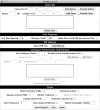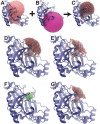POVME 2.0: An Enhanced Tool for Determining Pocket Shape and Volume Characteristics
- PMID: 25400521
- PMCID: PMC4230373
- DOI: 10.1021/ct500381c
POVME 2.0: An Enhanced Tool for Determining Pocket Shape and Volume Characteristics
Abstract
Analysis of macromolecular/small-molecule binding pockets can provide important insights into molecular recognition and receptor dynamics. Since its release in 2011, the POVME (POcket Volume MEasurer) algorithm has been widely adopted as a simple-to-use tool for measuring and characterizing pocket volumes and shapes. We here present POVME 2.0, which is an order of magnitude faster, has improved accuracy, includes a graphical user interface, and can produce volumetric density maps for improved pocket analysis. To demonstrate the utility of the algorithm, we use it to analyze the binding pocket of RNA editing ligase 1 from the unicellular parasite Trypanosoma brucei, the etiological agent of African sleeping sickness. The POVME analysis characterizes the full dynamics of a potentially druggable transient binding pocket and so may guide future antitrypanosomal drug-discovery efforts. We are hopeful that this new version will be a useful tool for the computational- and medicinal-chemist community.
Figures




Similar articles
-
A Comparative Study of the Structural Dynamics of Four Terminal Uridylyl Transferases.Genes (Basel). 2017 Jun 20;8(6):166. doi: 10.3390/genes8060166. Genes (Basel). 2017. PMID: 28632168 Free PMC article.
-
POVME: an algorithm for measuring binding-pocket volumes.J Mol Graph Model. 2011 Feb;29(5):773-6. doi: 10.1016/j.jmgm.2010.10.007. Epub 2010 Nov 3. J Mol Graph Model. 2011. PMID: 21147010 Free PMC article.
-
High resolution crystal structure of a key editosome enzyme from Trypanosoma brucei: RNA editing ligase 1.J Mol Biol. 2004 Oct 22;343(3):601-13. doi: 10.1016/j.jmb.2004.08.041. J Mol Biol. 2004. PMID: 15465048
-
Druggable pockets and binding site centric chemical space: a paradigm shift in drug discovery.Drug Discov Today. 2010 Aug;15(15-16):656-67. doi: 10.1016/j.drudis.2010.05.015. Epub 2010 Jun 4. Drug Discov Today. 2010. PMID: 20685398 Review.
-
The Trypanosome Flagellar Pocket Collar and Its Ring Forming Protein-TbBILBO1.Cells. 2016 Mar 2;5(1):9. doi: 10.3390/cells5010009. Cells. 2016. PMID: 26950156 Free PMC article. Review.
Cited by
-
Finding Druggable Sites in Proteins Using TACTICS.J Chem Inf Model. 2021 Jun 28;61(6):2897-2910. doi: 10.1021/acs.jcim.1c00204. Epub 2021 Jun 7. J Chem Inf Model. 2021. PMID: 34096704 Free PMC article.
-
Decoding the secrets: how conformational and structural regulators inhibit the human 20S proteasome.Front Chem. 2024 Jan 8;11:1322628. doi: 10.3389/fchem.2023.1322628. eCollection 2023. Front Chem. 2024. PMID: 38260042 Free PMC article.
-
Differential dynamics and direct interaction of bound ligands with lipids in multidrug transporter ABCG2.Proc Natl Acad Sci U S A. 2023 Jan 3;120(1):e2213437120. doi: 10.1073/pnas.2213437120. Epub 2022 Dec 29. Proc Natl Acad Sci U S A. 2023. PMID: 36580587 Free PMC article.
-
Analysis of the Contrasting Pathogenicities Induced by the D222G Mutation in 1918 and 2009 Pandemic Influenza A Viruses.J Chem Theory Comput. 2015 May 12;11(5):2307-14. doi: 10.1021/ct5010565. J Chem Theory Comput. 2015. PMID: 26321885 Free PMC article.
-
Recognition and stabilization of geranylgeranylated human Rab5 by the GDP Dissociation Inhibitor (GDI).Small GTPases. 2019 May;10(3):227-242. doi: 10.1080/21541248.2017.1371268. Epub 2017 Oct 25. Small GTPases. 2019. PMID: 29065764 Free PMC article.
References
-
- Perot S.; Sperandio O.; Miteva M. A.; Camproux A. C.; Villoutreix B. O. Druggable pockets and binding site centric chemical space: a paradigm shift in drug discovery. Drug Discovery Today 2010, 15, 656–667. - PubMed
-
- Levitt D. G.; Banaszak L. J. Pocket - a Computer-Graphics Method for Identifying and Displaying Protein Cavities and Their Surrounding Amino-Acids. J. Mol. Graphics 1992, 10, 229–234. - PubMed
-
- Kleywegt G. J.; Jones T. A. Detection, Delineation, Measurement and Display of Cavities in Macromolecular Structures. Acta Crystallogr., Sect. D: Biol. Crystallogr. 1994, 50, 178–185. - PubMed
Grants and funding
LinkOut - more resources
Full Text Sources
Other Literature Sources
